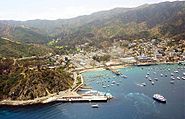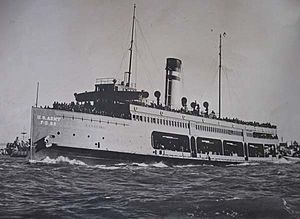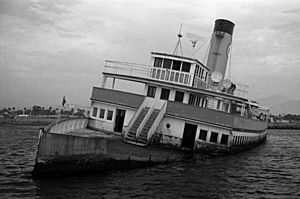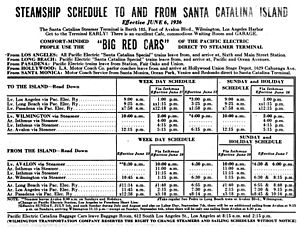SS Catalina facts for kids
class="infobox " style="float: right; clear: right; width: 315px; border-spacing: 2px; text-align: left; font-size: 90%;"
| colspan="2" style="text-align: center; font-size: 90%; line-height: 1.5em;" | 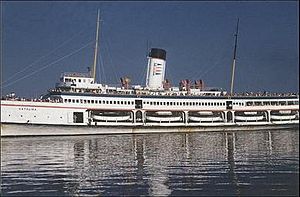
|} The SS Catalina, also known as The Great White Steamer, was a large steamship built in 1924. It carried passengers between Los Angeles and Santa Catalina Island from 1924 to 1975. This trip was about 26 miles long.
The Catalina carried more passengers than any other ship in history. From 1942 to 1946, it became a troop ferry for the U.S. Army, named FS-99. It moved over 800,000 soldiers. After its long career, the ship ran aground in Ensenada, Baja California in 1997 and partly sank. It was taken apart for scrap metal in 2009.
Contents
- Building the Catalina
- Passenger Trips to Catalina Island
- World War II Service
- End of Service and Abandonment
- Historic Importance
- The End of the Catalina
Building the Catalina
The Catalina was built by the Los Angeles Shipbuilding and Drydock Company. It was made for the Wilmington Transportation Company. This company served Catalina Island and was owned by William Wrigley Jr., who was famous for chewing gum.
The ship was designed to join other steamers like the Avalon and Cabrillo. It was meant to make the 25.5-nautical-mile trip from Los Angeles Harbor to Avalon in just one and a half hours.
The Catalina was a twin-screw steel steamer, meaning it had two propellers. It was built for daytime trips. It had a glass-enclosed main deck with a ballroom. There were also open areas at the front and back for passengers to enjoy the views.
The ship was about 301 feet long. It had a width of 52 feet at the main deck. It had five decks, and three of them were for passengers. A special feature was how the lifeboats were stored on the main deck. This made it easier to launch them quickly.
The Catalina was powered by two large steam engines. These engines were fed by four boilers. They were designed to produce 3,600 horsepower. Two generators provided electricity for the ship.
Work on the Catalina began on December 26, 1923. It was launched on May 3, 1924. The ship was ready for service on July 1, 1924. Building the ship cost about $1 million.
Passenger Trips to Catalina Island
Avalon harbor on Catalina Island
Between 1924 and 1975, the Catalina carried around 25 million passengers. They traveled between Los Angeles and Avalon Harbor on Catalina Island. This makes the Catalina the ship that has carried more passengers than any other vessel ever.
In its most popular years, the ship was called "The Great White Steamer." It could carry 2,000 passengers at a time. The trip to Catalina Island took about two and a half hours. Famous people like Presidents Calvin Coolidge and Herbert Hoover traveled on the ship. Many famous musicians from the Big Band era also enjoyed the trip.
The Los Angeles Times described the journey as entering a world of fancy leather seats and shiny wood. On the upper deck, people danced to big bands. Magicians and clowns entertained the passengers. Kids played hide-and-seek on the lower deck.
People in Avalon would gather to sing when the ship arrived. Speedboats would circle the ship, and water skiers would glide through its large wake. Closer to shore, children would swim out to dive for coins that passengers threw into the bay.
In 1958, the 26-mile trip to Catalina Island became famous in a song. The Four Preps had a hit song called "26 Miles (Santa Catalina)". The song reached number 2 on the U.S. music charts.
In 1960, the ship was sold to a group of investors. This happened because the owner, Phillip K. Wrigley, faced high taxes and union issues. The ship is also shown in the 1967 movie "Catalina Caper".
World War II Service
SS Catalina as US Army ship FS-99 in 1943
On August 25, 1942, the Catalina was given to the War Shipping Administration. It was then used by the War Department. The ferry was renamed FS-99 and became a Coastal Freighter and Passenger Vessel.
The US Army FS-99 was used to move troops. It carried soldiers from their camps to larger ships in the San Francisco Port of Embarkation. The ship could carry 2,500 troops. It had a civilian crew of 39 officers and men.
In 1946, the Army put a radar system on FS-99. This made it the first Army harbor ship to have radar. The radar helped the ship navigate in foggy conditions. On its first trip with the new radar, it found another Army ferry that was stuck in the fog.
The ship's last week of Army service was its busiest. It transported 12,764 Army personnel. The FS-99 was the last ship troops saw before going overseas. It was also the first ship they saw when returning from the Pacific. The ship returned to civilian service on April 22, 1946.
Overall, FS-99 moved about 820,000 military personnel. This was more than any other military transport in the San Francisco Bay area.
End of Service and Abandonment
By the early 1970s, smaller and faster ships made it hard for the Catalina to get passengers. So, it stopped passenger service in 1975.
In 1977, a real estate developer named Hymie Singer bought the Catalina for $70,000. He bought it as a Valentine's Day gift for his wife. The ship was moved to different places like Newport Beach and San Diego. There was even an idea to use the Catalina to carry tourists up the Nile River. However, the ship was too deep for the river.
As the ship moved from port to port, it faced problems. It broke free from its moorings twice in Long Beach. One time, it almost hit a large oil tanker. It seemed like the ship was fighting against its sad fate.
Catalinaaground and partly sunk in Ensenada Harbor
In 1985, Singer moved the ship to Ensenada, Baja California, Mexico. There, it was part of several failed business ideas. These included a floating discothèque and a bar and grill. In late 1997, the Catalina broke free again. It ran aground on a sandbar in Ensenada Harbor.
After that, the Catalina stayed half-submerged and stuck in the mud. Over the years, it became very decayed and rusty. Looters and vandals also stripped parts from the ship.
Historic Importance
The Catalina was recognized as a Los Angeles Historic-Cultural Monument. It was also a California Historical Landmark. In 1976, it was listed on the National Register of Historic Places.
People who wanted to save old buildings and ships tried to raise money. They hoped to bring the Catalina back to Los Angeles to fix it up. But others felt it was too late to save the ship.
1936 schedule for daily steamer service to Santa Catalina Island via Catalina, Avalon, and Cabrillo
The California Historical Landmark marker at the Port of Los Angeles, Berth 96, says:
- NO. 894 S.S. CATALINA - Often called the Great White Steamer, this ship was specially built by William Wrigley. It served his Catalina Island as a passenger ferry. It was named on May 23, 1924. During World War II, it was used to carry troops. But in 1946, it started its trips to Avalon again.
The End of the Catalina
The Catalina was finally taken apart after sitting in Ensenada Harbor for about 12 years. The process of scrapping the Catalina began in January 2009. It was finished by late 2009 or early 2010.
| History | |
|---|---|
| Name |
|
| Owner |
|
| Operator |
|
| Builder | Los Angeles Shipbuilding and Drydock Company |
| Laid down | December 26, 1923 |
| Launched | May 3, 1924 |
| Christened | May 3, 1924 |
| Completed | 1924 |
| In service | 1924–1975 |
| Out of service | September 14, 1975 |
| Fate | Partially sank in Ensenada harbor in 1997, scrapped 2009–2010 |
| General characteristics | |
| Tonnage | 1,766 GRT |
| Displacement | 2,390 tons at design mean draft |
| Length |
|
| Beam |
|
| Draft | 13 ft 5 in (4.1 m) at 2,390 tons |
| Decks | 5, 3 for passenger use |
| Installed power | 3 Hooven-Owens-Rentschler Co. triple expansion engines |
| Speed | 15.5 kts |
|
S.S. Catalina
|
|
| Location | Destroyed |
| Built | 1924 |
| Architect | Babcock & Wilcox |
| NRHP reference No. | 76000495 |
| Significant dates | |
| Added to NRHP | 1976-09-01 |


